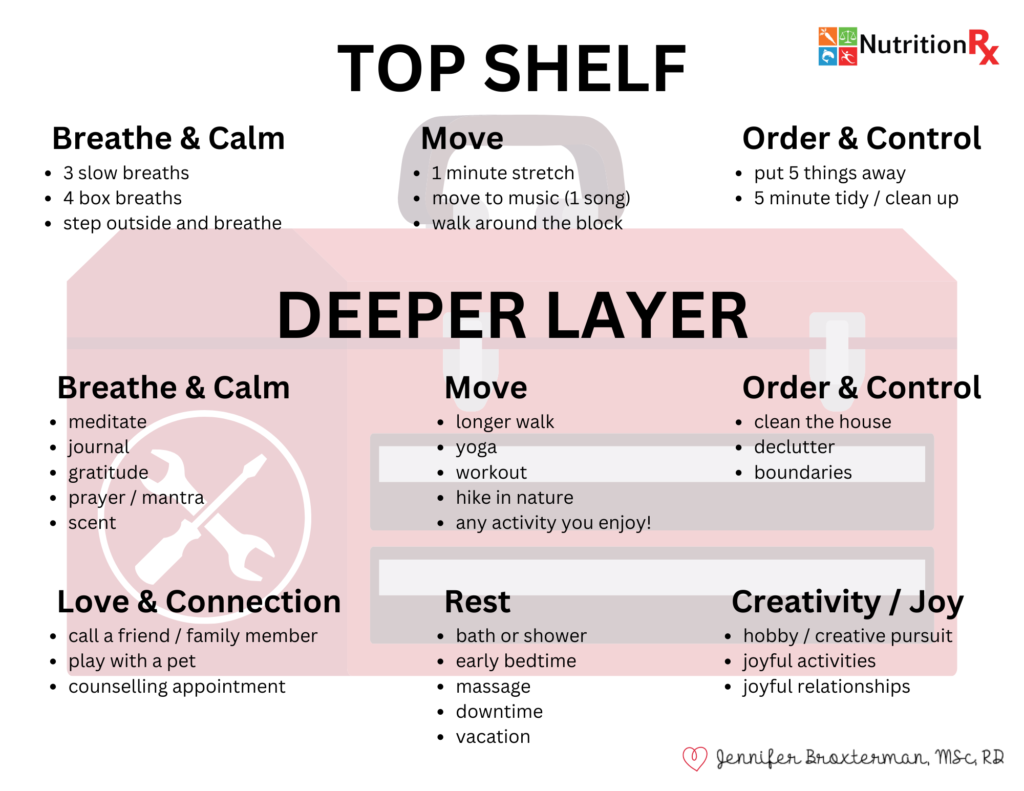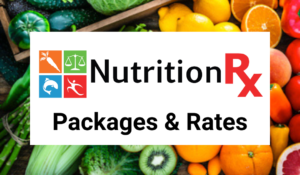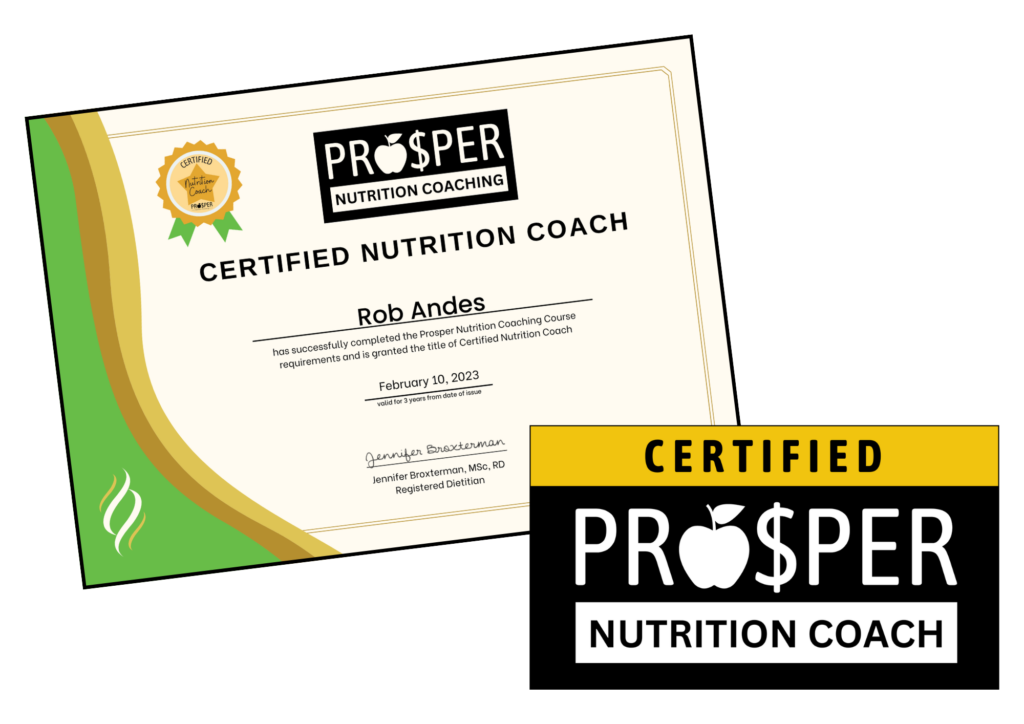

Stress Eating Toolbox
Written by:
Jennifer Broxterman, MSc, RD
Registered Dietitian
Would a reminder on your refrigerator door stop you in your tracks if you were on the verge of giving into stress eating? Surprisingly, after testing this out with a number of our NutritionRx clients, we found the answer is YES if done in the right way!
Many of our nutrition clients share with us that stress eating is one of the biggest obstacles they’re up against when it comes to following through on their positive intentions to eat healthy.
This is especially true when someone is feeling overwhelmed, anxious, or stressed out about life. That puts them in a vulnerable position to use food (or alcohol) to self-soothe unpleasant emotions or to try to ‘numb out’ from feeling anything at all.
Although it can be tempting to turn to food for comfort, in the long run, it can lead to weight gain, negative health effects, and feeling worse than when you started. Fortunately, there are many strategies to overcome food cravings and stress eating, and one of my favourite metaphors as a Registered Dietitian that I like to teach my clients is the idea of pulling a different tool from a “Stress Eating Toolbox” I designed to help you make it through moments when your anxiety and stress may be at an all-time high and food is calling your name to try to make yourself feel better.
The toolbox has two levels:
- A QUICK DRAW LEVEL (TOP SHELF) that’s immediate and easy to both grab and implement in times when you’re right on the edge of giving into a strong food craving.
- A DEEPER LAYER that may require a bit more planning or protecting in your schedule, but yields a very high return when it comes to our physical and mental health (and can help us overcome the cycle of stress eating).
PDF Download: Toolbox for Stress Eating
You’ll notice some of the helpful themes of the toolbox I share with my nutrition clients.
BREATHE & CALM
Top Shelf
- 3 slow breaths
- 4 box breaths
- step outside and breathe
Deeper Layer
- meditate
- journal
- gratitude
- prayer / mantra
- scent (e.g. aromatherapy)
BREATHE & CALM
One helpful tool is to use breathing and calming techniques to reduce stress levels. By taking a moment to simply breathe, this calms our brain and keeps us present and mindful to the moment instead of ‘going offline’ and dragging us into auto-pilot mode as we reach for the cookies, ice cream, or chips to feel better in the moment, albeit if only temporarily.
Taking three slow breaths or practicing four box breaths (inhaling for four counts, holding for four counts, exhaling for four counts, and holding for four counts) can help to calm the mind and decrease stress. Additionally, stepping outside and breathing in fresh air can also be helpful in reducing stress levels.
MOVE
Top Shelf
- 1 minute stretch
- move to music (1 song)
- walk around the block
Deeper Layer
- longer walk
- yoga
- workout
- hike in nature
- any activity you enjoy!
MOVE
Another effective strategy is to get some movement. This could mean going for a walk outside, dancing around to some music, doing a workout, or any other physical activity that gets your blood pumping. Moving your body can help to release endorphins, which can boost your mood and reduce stress levels.
As we like to remind people:
“Action increases momentum (and motivation).”
.. so creating a quick win with some simple physical activity is a great way to feel better in the moment without turning to food for comfort.
ORDER & CONTROL
Top Shelf
- put 5 things away
- 5 minute tidy / clean up
Deeper Layer
- clean the house
- declutter
- (healthy) boundaries
ORDER AND CONTROL
When things feel out of control in our lives and our anxiety is spiked, sometimes escaping from reality and getting a dopamine and serotonin rush from a sugar high is our brain’s way of trying to help us feel better, even if it’s a misguided attempt. Learning to find healthy coping mechanisms when feeling overwhelmed is the first step in breaking this pattern. Oftentimes, one of the best antidotes to high levels of anxiety is to create order and control in a healthy way around you. For example, start by putting five things away or doing a five-minute tidy to put your space back in order. Cleaning and decluttering your home to get rid of unnecessary items promotes a more peaceful and calm living space. Additionally, setting healthy boundaries with others can help reduce stress and create a more positive outlook. By focusing on creating order and control in your environment and relationships, you can better manage anxiety and avoid unhealthy coping mechanisms like stress eating.
ADDITIONAL STRATEGIES
Love & Connection
- call a friend / family member
- play with a pet
- book a counselling appointment
Rest
- take a bath or shower
- early bedtime
- book a massage
- permission to give yourself downtime
- go on vacation
Creativity / Joy
- hobby / creative pursuit
- joyful activities
- joyful relationships
Finally, finding a more productive way to rest can be another helpful strategy for stopping stress eating. This could involve taking a relaxing bath or shower, getting an early bedtime, booking a massage, scheduling downtime and taking a break from work, or even planning a vacation. By finding more positive ways to relax and unwind, you can reduce stress levels and avoid turning to food for comfort.
Spending time with loved ones, pets, or even getting lost in a flow state in a hobby that we enjoy are also great ways to ‘fill our cups’ so to speak with the people and activities that bring meaning and joy into our lives.
In conclusion, stress eating can be a challenging habit to break, but by using these tools and strategies, you can stop it in its tracks. By reminding ourselves of this Stress Eating Toolbox and focusing on breathing and calming techniques, getting some movement, and finding more productive ways to rest, you can reduce stress levels and avoid turning to food for comfort.
Wishing you health & happiness,
♡ Jen
Jennifer Broxterman, MSc, RD
Registered Dietitian
NutritionRx: happy, healthy living with our team of Registered Dietitians
Prosper Nutrition Coaching: a world-class nutrition coaching certification
+
+
+
Want to work with a NutritionRx Registered Dietitian?
Learn more here: Nutrition Packages & Rates
+
+
+
Want to become a Certified Nutrition Coach?
Learn more about our habits-based Prosper Nutrition Certification








